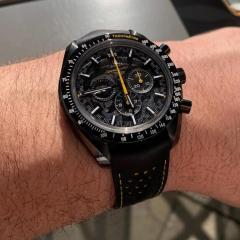Case back removal
-
Recently Browsing
- No registered users viewing this page.
-
Topics
-
Posts
-
By Neverenoughwatches · Posted
That was the intial reason I used mine the one time, timegrapher wouldn't pick up a signal, but it turned out to be something else. For fairly rare events like this, you're probably better off using Nicklesilver's method, or use an accurate pocket watch to match the oscillations up to. I think the tool is best suited to folk that time balances regularly, as would have been the case years ago. Maybe for small companies that let out their hairspring timing services, that didn't have the movement to work with. At the end of the day you already have the perfect timing device....the actual movement. The tool's convenience merely saves you the time and effort of unpinning and repinning the hairspring to the stud a few times to get it right. Providing a " Prior Idiot " hasn't fitted incorrect train wheels 😄 -
By SwissSeiko · Posted
If you restaff the balance correctly, there should be no need to repoise the wheel, unless it was messed with by a previous watchmaker. Here is an experiment to try that will explain my findings. Remove the balance from a correctly running watch that is marked "adjusted to 5 or 6 positions" or however many they claim. Place it on your poising tool, and you will find that it is out of poise. But, being out of poise, it has been adjusted for positional adjustments, to average the 5 or 10 seconds a day. It seems like you would want the wheel to be perfectly weighted all around, but it might run better a little heavier CU at the 4:30 position on the wheel. HERE is a good article that can explain it better than me. I also see a large amount of bad repairs, back when it was a cutthroat occupation. So if someone did re-poise a balance before you, you might have to do it again to correct it for positional accuracy. But at that point, its a sunken cost fallacy, as it will take a long time to make adjustments to 6 positional accuracy, so you might be better off finding an unmolested replacement. -
By Neverenoughwatches · Posted
This is a little clearer with the directions added. The spring must pull the click back not push. So the opposite way to which the click is being pulled into the teeth. As though its being opened out. Haha you've got it ! I didnt see the picture . Needs to come further around cw. Closer to the long leg.
-








Recommended Posts
Join the conversation
You can post now and register later. If you have an account, sign in now to post with your account.
Note: Your post will require moderator approval before it will be visible.